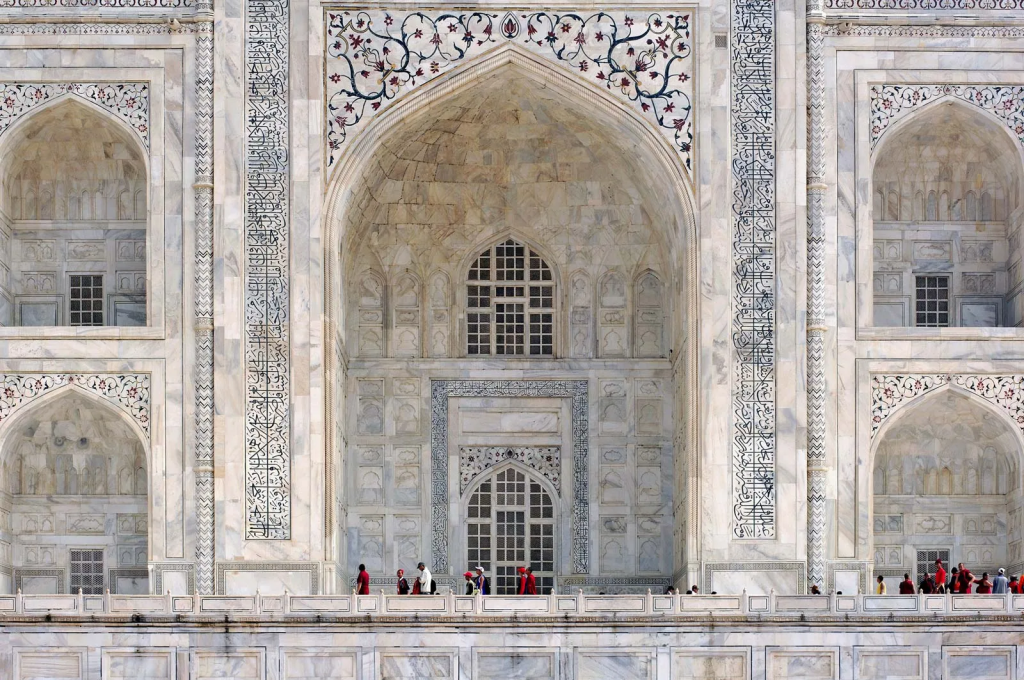The Taj Mahal is an ivory-white marble mausoleum on the south bank of the Yamuna River in the Indian city of Agra. It was commissioned by the Mughal emperor, Shah Jashan, to house the tomb of his favorite wife Mumtaz Mahal.

The tomb is the centerpiece of a 17-hectare complex, which includes a mosque and a guest house, and is set in formal gardens boarded on the three sides by a crenelated wall.
The Taj Mahal was designated as a UNESCO world heritage site in 1983 for being ‘the jewel of Muslims art in India and one of the universally admired masterpieces of the world’s heritage.’ It is regarded by many as the best example of Mughal architecture and a symbol of India’s rich history.
Read: Elon Musk recalls visit to Taj Mahal
Construction of The TAJ MAHAL
The specialists of each procession were called to work on a site that brings together the peak of activities of up to 20,000 people. It was started in 1631, and 7 years later, in 1648, the mausoleum hard was completed. In 1658, 5 years later, is the year that that the enclosure, the ancillary buildings, and especially the gardens were completed.

The architecture of The Taj Mahal is clearly Indo-Islamic. It is a style combining Hindu art, traditional in this territory and Islamic-this religion has been conveyed so far.
The territory, historically populated by non-muslims, delivered a workforce that was not used to the Islamic style. However, it was under the direction of Muslim artists that they were built, hence the intertwined vegetation, the work of Lapidary marquetry, and the dome of lotus which is the flagship of the Taj Mahal, a synthesis of Islamic art and Hinduism.

Unfortunately, it’s difficult to know who built The Taj Mahal. At the time, the name of the initiator of the project, Shah Johan, was more to be remembered than the workers or even architects.
Contrary to popular belief, The Taj Mahal’s mausoleum is not made of marble, it is only covered. Indeed, the walls of the monument are red bricks, made on site for obvious reasons of transport.
The huge marbles were made in Makrana, southeast of Japur, about four hundred kilometers away. To transport them, the stonecutters had to rent trolleys whose expenses were charged to the royal treasury. The logs were cut with great precision, without any cracks.

Location of The TAJ MAHAL
The Taj Mahal had to be on the edge of the Yamuna for several reasons. First of all, water is on the four rivers of Paradise according to Qur’an, so it is logical that a tomb is near a river. Then the Yamuna, which crosses Agra, is a tributary of the Ganges, the purifying river of the Hindu religion, so by placing the deceased here, her soul will naturally be purified for the Hindu people on which reigned Shah Johan.
Initially, the land on which The Taj Mahal was built belonged to Raja Jai Singh. He agreed to give it to the emperor for four houses in the city center.
Also Read: The Great Wall of China
Cost of construction
How much did it cost to build The Taj Mahal? This is a question that is not so difficult to answer because the work was the subject of a transaction between the site manager and the craftsmen from all over working on it. Thanks to those lists, of Persian origin, we have an idea of the cost of The TAJ Mahal. It is a little over 41,848,420 Rupees.
UNESCO; the Taj Mahal is a world heritage site.
Taj Mahal is considered to be the greatest architectural achievement in the whole range of Indo-Islamic architecture. It’s recognized architectonic beauty has a rhythmic combination of solids and voids; concave and convex and light shadows; such as arches and domes further increase the aesthetic aspect. The color combination of lush green, scape reddish pathway, and blue sky over it showcases the monument on ever-changing tints and moods. The relief work in marble and inlay with precious and semiprecious stones made it a monument apart.
The integrity of The TAJ Mahal is maintained in the intactness of tombs, mosques, guest houses, main gates, and the whole Taj Mahal complex. The physical fabric is in good condition and structural stability, nature of the foundation, vertically the minerals, and other constructional aspects of the Taj Mahal have been studied and continue to be monitored.
To control the impact of deterioration due to atmospheric pollutants, an air-controlling monitoring station is installed to constantly monitor air quality and control decay factors as they arise.
To ensure the protection of the settings, adequate management, and enforcement of regulations in the extended buffer zone is needed. In addition, future development for tourist facilities will need to ensure that the functional and visual integrity of the property is maintained particularly in the relationship with the Agra Fort.
What’s inside The Taj Mahal?
Inside The Taj Mahal, the cenotaphs honoring Mumtaz Mahal and Shah Johan are enclosed, in an eight-sided chamber ornamented by pietra dura (an inlay with semiprecious stones) and a marble lattice screen. But the gorgeous monuments are just for show. The real sarcophagus is in a quiet room below the garden level.
Declared a winner of the New Seven Wonders of the world
The Taj Mahal attracts more than 6 million visitors a year, and in 2007, it was declared a winner of the New Seven Wonders of the world (2000-2007) initiative.






[…] Read: INSIDE THE TAJ MAHAL; INDIA’S HERITAGE, A WORLD WONDER. […]